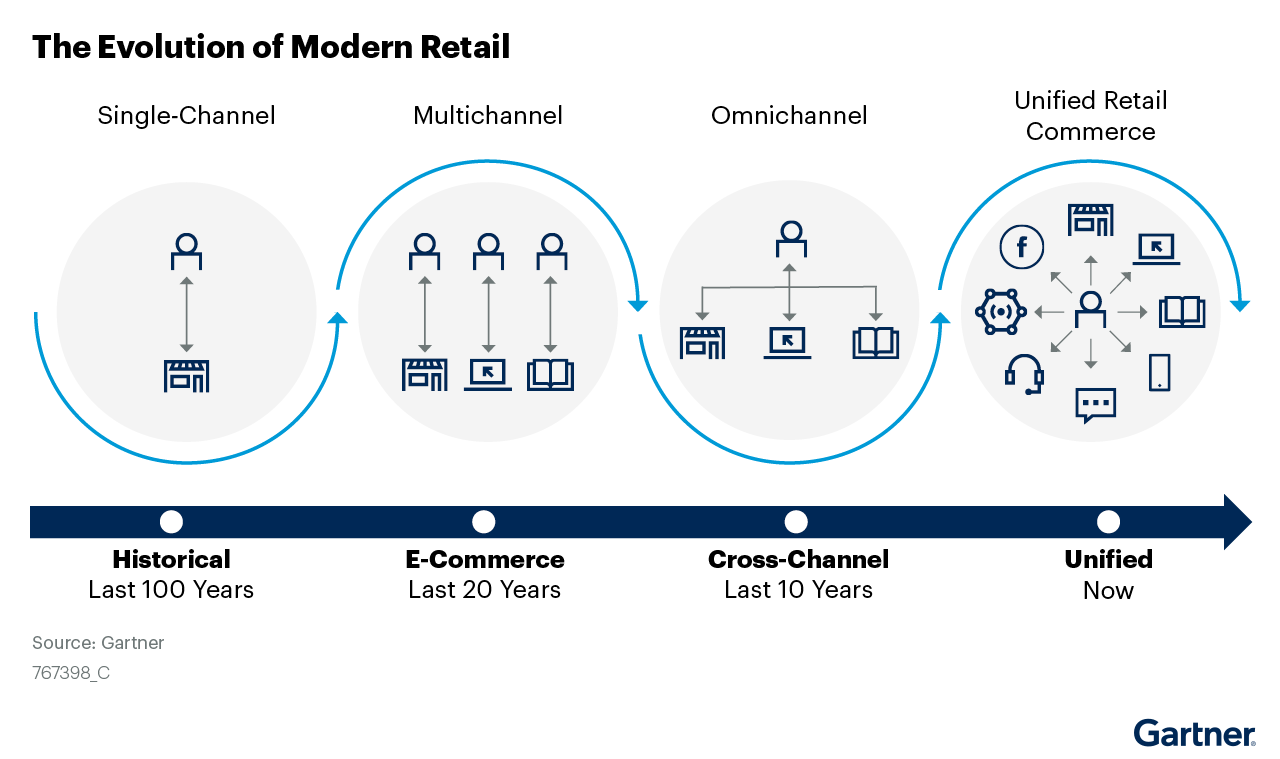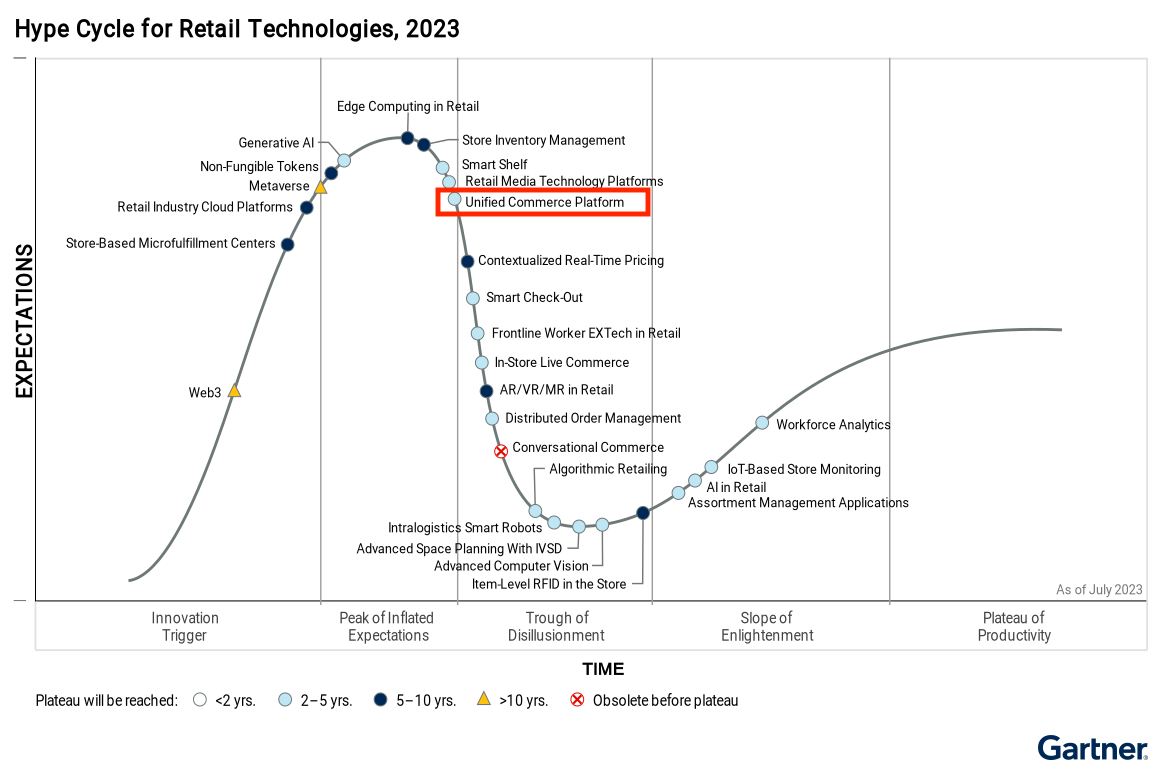What is Unified Commerce and why it matters for retailers

In today’s rapidly evolving retail landscape, the concept of Unified Commerce has emerged as a transformative force, reshaping the way retailers engage with consumers. Gone are the days of disparate channels operating in silos.
What is Unified Commerce?
Unified commerce is the natural evolution from previous legacy attempts to connect customer touchpoints. Traditionally, multichannel retailers had separate systems — such as inventory management, customer data, ERP, distributed order management, e-commerce and point of sale — developed for each channel.
Because these systems are usually not integrated well with each other, they act as data silos gathering redundant or limited data, with the retailers’ core systems unable to communicate with each other. If they could, however, it would rarely be in real time.
The result of this strategy is channel silos, and specific operations in each of them, which hinder a unified view of customer interactions and limit the retailer’s insight into how consumers engage with the brand.
One of the key benefits of unified commerce is the integration between all digital and physical touchpoints, with the store as a strong executional hub that can support future immersive experiences.
How is Unified Commerce different from omnichannel commerce?
We used to compare unified commerce to omnichannel as two totally different strategies, but in reality, unified commerce is not an entirely new strategy. What we’re talking about here is that, there are some architectural capabilities that support it, specifically, the centralization of platforms that have the ability to integrate all of the disparate or silo technology platforms that sit around it in real time and has the ability to move and share that data across any touchpoint or across any business function within that retail environment.

When we move away from omnichannel and into this reactive environment, retailers will gain a lot more business intelligence and consumers will have more fluid experiences.
And this is critical for retailers because we now have a long list of different retail touchpoints, and they must be able to converge all of those touchpoints and actually provide the same consumer experience regardless of any of them, which are currently and historically quite disparate for consumers.
Unified commerce provides retail consumers with a continuous experience as they browse, transact, acquire and consume, regardless of touchpoints. This is a fundamental difference compared with omnichannel retail, which focuses on consistent cross-channel experience for discrete activities. In omnichannel, customers can choose their preferred channel or touchpoint for an activity and it ensures a consistent experience for that particular activity. Unified commerce offers not only a consistent cross-channel experience but also a continuous experience through customers’ journeys.
Three pillars supporting Unified Commerce
According to Gartner, 3 pillars support the execution of a successful unified commerce execution (1).
- The first pillar is centered on unification. To unify the front end experience for consumers, retailers must be able to unify all of the back end technology stack and different platforms, applications, and systems within a retail environment.
- The second pillar is centered on experience. The customer experience has always been the critical differentiator for every retail strategy. And we still say it is a critical differentiator in unified commerce. But there is another experience that is even more important, and that is the associate experience in the retail environment. Because you will never be able to deliver an excellent, engaging, and compelling customer experience unless you have an associate experience to back it up. In fact, when we talk about unified commerce, the associate experience is the primary differentiator because they will be handling all of this real-time data about products, services, inventory, and customer information.
- And the third pillar is composability. Composable technology platforms allow the retailer to become more agile to respond to rapidly changing customer behaviors. It also covers the ability for customers and for sales associates to build more composability in terms of their own journeys within a physical store environment.
Need for Unified Commerce accelerates
There has never been a greater need for unified retail commerce. Recent market disruption has exposed the punishing gaps within retailer ecosystems, demonstrating that many retailers continue to operate as multichannel retailers in silos rather than delivering true unified commerce.
Retailers are also threatened by increased expectations from customers who can easily switch between retailers, making a good understanding of customer shopping behavior critical. As a result, we can see how customer experience and business agility have emerged as key competitive differentiators in modern retailing.
The interest in Unified Commerce platforms was also confirmed in the latest Gartner Hype Cycle for Retail Technologies 2023 (2), one of the most valued reports by retail professionals that we had the opportunity to discuss in one of our webinars and that you can now watch on-demand. Unified Commerce Platforms are at the peak of inflated expectations, as it has been for the last couple of years. And this essentially means that retailers are still heavily investing in these types of technologies.

Unified Commerce Platforms anchored by POS
Notably, for 90% of retailers with a physical store estate today, the base of this centralized platform is provided by a unified commerce platform anchored by a POS solution. Unified Commerce platforms like the one from Orisha | Openbravo, recognized in the 2024 Gartner® Market Guide for Unified Commerce Platforms Anchored by POS for Tier 2 Retailers (2).
These platforms incorporate POS solutions providing support to key unified commerce functions today such as mobility, order orchestration, flexible loyalty and discounting capabilities, real-time stock management and clienteling. The interest in this type of platforms has increased in the last 18-24 months due in part, to the extensibility and scalability that the platforms provide, but more significantly, due to the requirement to meet new and emerging customer expectations at scale.
(1) Gartner, Deliver a Unified Retail Commerce Experience Using 3 Top Practices, By Max Panther Hammond, Robert Hetu, Kelsie Marian, Jonathan Kutner, Sandeep Unni, Hanna Karki, Tom Nolan, 2 May 2023.
(2) Garter, Hype Cycle for Retail Technologies, 2023, By Max Panther Hammond, 25 July 2023.
(3) Gartner, Market Guide for Unified Commerce Platforms Anchored by POS for Tier 2 Retailers, By Max Panther Hammond, 29 January 2024.



